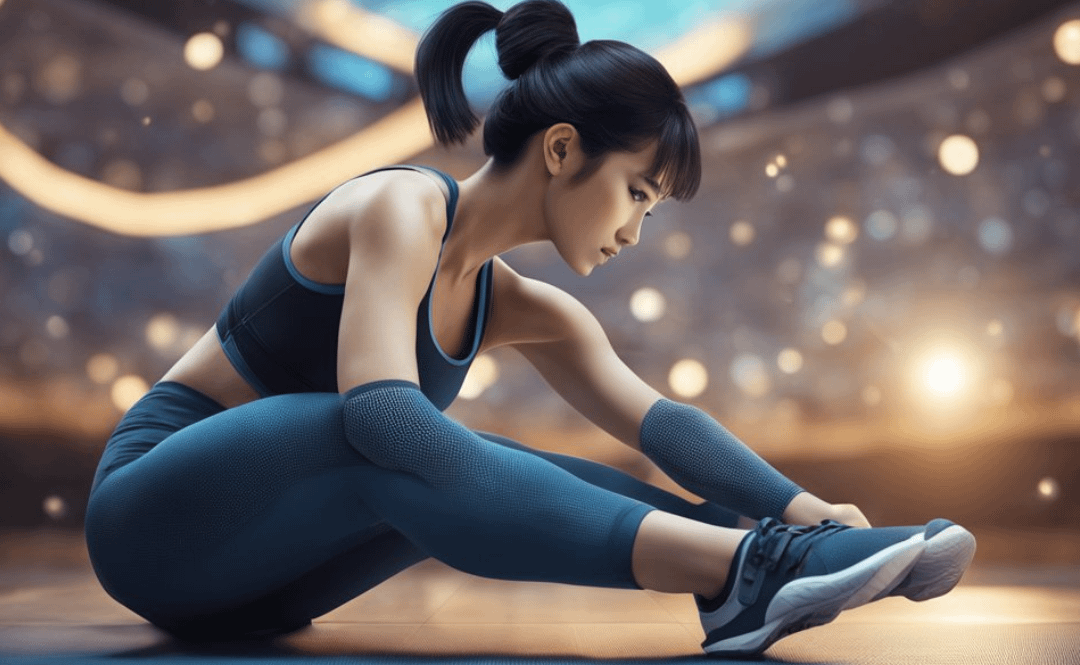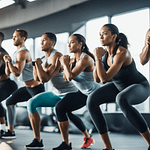Flexibility and mobility are two essential components of a healthy body. As we age, our muscles and joints tend to become less flexible, leading to stiffness, pain, and reduced range of motion. Flexibility training can help improve mobility, reduce the risk of injury, and enhance overall physical performance.

Understanding Flexibility and Mobility
Flexibility refers to the ability of our muscles and joints to move through their full range of motion. Mobility, on the other hand, refers to the ability to move freely and easily without pain or discomfort. While flexibility and mobility are closely related, they are not the same thing. A person can have good flexibility but poor mobility if they lack the strength and stability to move through a full range of motion.
The Role of Stretching Stretching is one of the most effective ways to improve flexibility and mobility. It helps to lengthen muscles, increase joint mobility, and improve circulation. Regular stretching can also help to prevent muscle imbalances, reduce the risk of injury, and alleviate pain and stiffness. Building a mobility training program that includes stretching exercises can help improve overall flexibility and mobility, leading to better physical performance and a reduced risk of injury.
Overview
Key Takeaways
- Flexibility and mobility are essential components of a healthy body.
- Stretching is an effective way to improve flexibility and mobility.
- Building a mobility training program can help improve overall physical performance and reduce the risk of injury.
Flexibility Vs Mobility
Defining Flexibility and Mobility
Before we dive into the importance of flexibility training for better mobility, let’s first define what we mean by flexibility and mobility. Flexibility refers to the ability of our muscles to lengthen and stretch, allowing us to move our joints through a full range of motion. Mobility, on the other hand, refers to the ability of our joints to move freely and easily through that range of motion.
The Importance of Range of Motion
Having good flexibility and mobility is crucial for maintaining a healthy body. When we have limited range of motion in our joints, we may experience stiffness, pain, and discomfort. This can make it difficult to perform everyday tasks and can even lead to injury.
By incorporating flexibility training into our workouts, we can improve our range of motion and reduce our risk of injury. Stretching exercises can help to lengthen and loosen tight muscles, allowing us to move our joints more freely.
How Aging Affects Flexibility
As we age, our flexibility and mobility naturally decline. This is because our muscles and joints become stiffer and less elastic over time. However, this decline is not inevitable and can be slowed down through regular exercise.
By incorporating flexibility training into our exercise routine, we can maintain our range of motion and keep our joints healthy as we age. This can help to prevent common age-related conditions such as arthritis and osteoporosis.
In conclusion, understanding the difference between flexibility and mobility is important for maintaining a healthy body. Incorporating flexibility training into our workouts can help to improve our range of motion and reduce our risk of injury. As we age, it becomes even more important to maintain our flexibility and mobility through regular exercise and stretching.
The Role of Stretching
Stretching is an essential component of flexibility training that helps improve mobility, range of motion, and reduce the risk of injury. It involves lengthening and elongating the muscles to improve their flexibility and elasticity. In this section, we will discuss the different types of stretching, dynamic vs. static stretching, and how to create a stretching routine.
Types of Stretching
There are two main types of stretching: dynamic stretching and static stretching. Dynamic stretching involves moving the muscles through a full range of motion, while static stretching involves holding a stretch for a prolonged period. Both types of stretching have their benefits and are useful for different purposes.
Dynamic vs. Static Stretching
Dynamic stretching is best suited for warming up before exercise or physical activity. It helps increase blood flow to the muscles, improve flexibility, and prepare the body for movement. Examples of dynamic stretching exercises include walking lunges, high knees, and leg swings.
On the other hand, static stretching is best suited for cooling down after exercise or physical activity. It helps reduce muscle tension, increase flexibility, and improve range of motion. Examples of static stretching exercises include hamstring stretches, quad stretches, and calf stretches.
Creating a Stretching Routine
To create an effective stretching routine, it is essential to incorporate both dynamic and static stretching exercises. Start with dynamic stretching exercises to warm up the muscles and prepare the body for movement. Then, move on to static stretching exercises to cool down and improve flexibility.
It is also important to stretch all major muscle groups, including the neck, shoulders, back, hips, hamstrings, quads, and calves. Hold each stretch for 15-30 seconds and repeat each stretch 2-3 times.
In conclusion, stretching plays a critical role in improving mobility, range of motion, and reducing the risk of injury. Incorporating both dynamic and static stretching exercises into your routine can help you achieve optimal results. Remember to stretch all major muscle groups and hold each stretch for 15-30 seconds.
Building a Mobility Training Program

When building a mobility training program, it is important to consider the specific needs of the individual. Incorporating mobility work into a regular exercise routine can help improve joint mobility and prevent injury.
Incorporating Mobility Work
Mobility work should be incorporated into a warm-up routine before any strenuous exercise. This can include exercises such as foam rolling, dynamic stretching, and joint mobilization. These exercises can help prepare the body for the workout ahead and improve flexibility.
Flexibility Exercises for Key Muscle Groups
Stretching key muscle groups such as the hips, shoulders, neck, and spine is important for improving mobility. Hip flexors and hamstrings are often tight in many individuals and can be stretched using exercises such as lunges, leg swings, and hamstring stretches. Shoulder stretches such as wall slides and arm circles can help improve shoulder mobility. Neck and spine stretches such as cat-cow stretches and spinal twists can help improve mobility in these areas.
Progression and Adaptation
It is important to progress and adapt a mobility training program to prevent plateaus and continue to improve mobility. This can include increasing the intensity or duration of exercises and incorporating new exercises to challenge the body. Strengthening exercises can also be incorporated to improve joint stability and prevent injury.
In conclusion, building a mobility training program can help improve joint mobility and prevent injury. Incorporating mobility work into a warm-up routine, stretching key muscle groups, and progressing and adapting the program can help individuals improve their overall mobility and flexibility.
Preventing and Managing Pain and Injury

Flexibility training can be an effective way to improve mobility, but it is important to be aware of the potential risks and take steps to prevent and manage pain and injury. Here are some strategies to help you stay pain-free while improving your flexibility:
Common Flexibility-Related Injuries
Some of the most common injuries associated with flexibility training include strains, sprains, and muscle soreness. These injuries can be caused by overstretching or pushing your body too hard, too fast. It is important to start slowly and gradually increase the intensity and duration of your stretching and mobility exercises.
Strategies for Pain-Free Mobility
To prevent injury and manage pain, it is important to listen to your body and stay within your comfort zone. If a stretch or exercise feels painful or uncomfortable, you may be pushing yourself too hard. Instead, try modifying the exercise or reducing the intensity until you feel comfortable.
Another strategy for pain-free mobility is to incorporate other forms of exercise, such as strength training or low-impact cardio, into your routine. These exercises can help improve your overall fitness and support your joints, reducing the risk of injury.
When to Seek Professional Help
If you experience joint pain or arthritis, it is important to consult with a healthcare professional before starting a new exercise routine. They can help you develop a safe and effective program that takes into account your specific needs and limitations.
If you do experience pain or injury during your flexibility training, it is important to seek professional help. Physical therapy can be an effective way to manage pain and improve mobility, and a qualified physical therapist can help you develop a personalized treatment plan to address your specific needs.
In summary, while flexibility training can be a great way to improve mobility, it is important to take steps to prevent and manage pain and injury. By starting slowly, staying within your comfort zone, and seeking professional help when needed, you can stay pain-free and enjoy the benefits of improved flexibility and mobility.
Flexibility and Mobility in Everyday Life

As we go about our daily lives, we often take for granted the mobility and flexibility of our bodies. However, poor posture, lack of exercise, and aging can cause a decline in mobility and flexibility, which can lead to falls and other injuries. By incorporating flexibility and mobility training into our daily routines, we can improve our overall health and well-being.
Applying Mobility Training to Daily Activities
Mobility training involves exercises that improve the range of motion of our joints and muscles. By incorporating mobility exercises into our daily activities, we can improve our posture, balance, and coordination. For example, we can practice standing on one leg while brushing our teeth or doing squats while waiting for the bus. These simple exercises can help us maintain our mobility and prevent falls.
Flexibility for Athletes and Older Adults
Flexibility is also important for athletes and older adults. For athletes, flexibility can improve their performance and reduce the risk of injury. For older adults, flexibility can improve their balance and reduce the risk of falls. By incorporating stretching exercises into their daily routines, athletes and older adults can improve their flexibility and mobility.
Long-Term Benefits of Improved Mobility
Improving our mobility and flexibility can have long-term benefits for our overall health and well-being. By improving our core muscles, we can improve our posture and reduce the risk of back pain. By improving our endurance, we can improve our cardiovascular health and reduce the risk of heart disease. By improving our mobility and flexibility, we can improve our quality of life and maintain our independence as we age.
In conclusion, incorporating flexibility and mobility training into our daily routines can have a positive impact on our overall health and well-being. By improving our posture, balance, and coordination, we can prevent falls and other injuries. By improving our flexibility and mobility, we can improve our performance in sports and maintain our independence as we age.
Flexibility Training Equipment
Top-Rated Stretching Equipment for Enhanced Flexibility
Looking to enhance your flexibility and take your stretching routine to the next level? Check out our curated list of top-rated stretching equipment, perfect for dancers, gymnasts, and anyone looking to improve their range of motion. Our selection is sorted by customer ratings, ensuring you get the best products to meet your fitness goals.
| Product Short Name | Rating | Price |
|---|---|---|
| OPTP Original Stretch Out Strap with Poster | 4.7 | $15.95 |
| Premium Door Leg Stretcher for Flexibility | 4.6 | $17.95 |
| DEHUB Elastic Yoga Stretching Strap | 4.6 | $9.99 |
| IdealStretch Original Hamstring Stretcher Device | 4.6 | $71.95 |
| Nitpicker Stretching Straps | 4.4 | $6.43 |
| tchrules Door Flexibility Leg Strap | 4.4 | $12.59 |
| AmazeFan 3 Bar Leg Split Machine | 4.3 | $32.98 |
| 3 Bar Stainless Steel Leg Stretcher | 4.3 | $37.99 |
| Jayefo Sports Leg and Foot Stretcher | 4.2 | $8.99 |
| SigridZ Thigh Master | 4.1 | $9.99 |
| Yes4All Foot Rocker | 4.1 | $13.49 |
*Please note that prices are subject to change and may vary depending on the seller, location, and any applicable discounts or promotions. The ratings provided are based on customer reviews and may also change over time. Amazon Affiliate Link.







